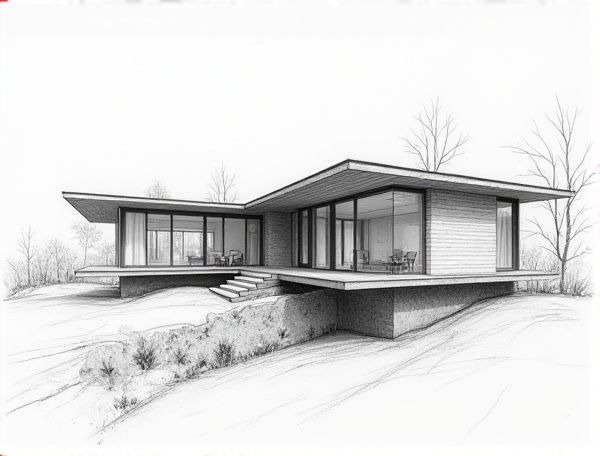
Photo illustration: Passive solar home design with trombe wall
Trombe walls harness solar energy by absorbing heat through a sun-facing, dark-colored surface behind glass, then slowly releasing warmth into your home, reducing heating costs and improving energy efficiency. Discover how incorporating a Trombe wall can transform your passive solar home design by reading more in the article.
Introduction to Passive Solar Home Design
Passive solar home design optimizes building orientation, window placement, and materials to harness natural sunlight for heating and cooling, reducing energy consumption. Techniques such as thermal mass, proper insulation, and shading enhance indoor comfort by stabilizing temperature fluctuations throughout the day.
What is a Trombe Wall?
A Trombe Wall is a passive solar building feature consisting of a thick, south-facing wall painted dark and covered with glass that absorbs and stores solar heat during the day, slowly releasing it into your home at night to maintain comfortable temperatures. This energy-efficient design reduces heating costs by harnessing natural sunlight for thermal regulation in your living space.
Key Principles of Passive Solar Heating
Passive solar heating relies on strategic building orientation, maximizing south-facing windows to capture sunlight while using thermal mass materials like concrete or stone to store and gradually release heat. Proper insulation and airtight construction minimize heat loss, ensuring efficient temperature regulation and reducing reliance on active heating systems.
Benefits of Incorporating a Trombe Wall
Incorporating a Trombe Wall enhances passive solar heating by absorbing and slowly releasing solar energy, significantly reducing reliance on conventional heating systems and lowering energy bills. This sustainable design element also improves indoor thermal comfort and contributes to eco-friendly home construction by minimizing carbon emissions.
Essential Components of a Trombe Wall System
A Trombe wall system incorporates a thick, south-facing masonry wall painted dark to absorb solar heat, topped by a single or double layer of glass glazing that creates an insulating airspace. Thermal mass storage within the wall gradually releases stored heat into the interior through conduction and radiation, enhancing passive solar heating efficiency while incorporating vents for controlled ventilation.
Site Orientation and Design Considerations
Effective site orientation maximizes natural light, improves energy efficiency, and enhances indoor comfort by strategically positioning windows, walls, and outdoor spaces according to sun path and prevailing winds. Design considerations include topography, vegetation, and local climate, ensuring sustainable integration with the environment while optimizing views and privacy.
Materials and Construction Techniques
Selecting sustainable materials like bamboo, reclaimed wood, and low-VOC paints significantly enhances eco-friendly home design while ensuring durability and aesthetic appeal. Advanced construction techniques such as modular building and insulated concrete forms improve energy efficiency and reduce construction time. Integrating these materials and methods supports robust, cost-effective, and environmentally responsible home structures.
Energy Efficiency and Climate Suitability
Energy-efficient home designs leverage high-performance insulation materials, double-glazed windows, and smart HVAC systems to reduce energy consumption while maintaining indoor comfort adapted to local climate conditions. Incorporating passive solar heating, natural ventilation, and climate-responsive building orientations optimizes thermal regulation and minimizes reliance on artificial heating and cooling, enhancing sustainability and reducing utility costs.
Maintenance and Long-Term Performance
Regular maintenance of HVAC systems, roofing, and plumbing ensures your home's long-term performance and prevents costly repairs. Investing in durable materials and timely inspections enhances energy efficiency and preserves the structural integrity of your property.
Future Trends in Passive Solar Design
Future trends in passive solar design emphasize integrating advanced materials like dynamic glazing and phase change materials to optimize thermal regulation and energy efficiency. Your home can benefit from smart shading systems and adaptive building orientations that respond to seasonal solar variations, reducing reliance on artificial heating and cooling.
 homedesy.com
homedesy.com